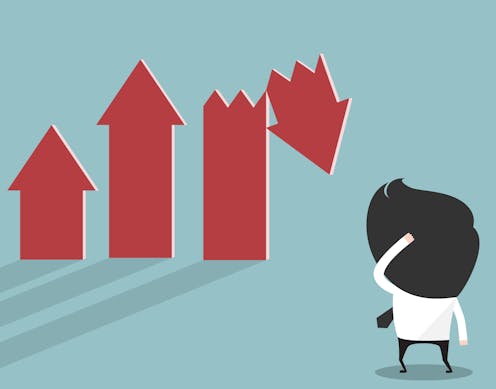Latest NZ unemployment figure may not give a true picture of the number of people out of work
- Written by Ananish Chaudhuri, Professor of Behavioural and Experimental Economics, University of Auckland

New Zealand’s unemployment rate dropped to 4.9%[1] in the December quarter, down from 5.3% in the previous quarter. One commentator argued[2] this drop clearly establishes that a strong health response from the government was also the best economic response.
That may well be true but the conclusion is not obvious based on the data we have at our disposal.
The Stats NZ report[3] that provides the unemployment information also points out that despite this quarterly fall, the number of unemployed people is still 25,000 (about 22%) higher than it was a year ago.
More people on job keeper support
In the meantime, according to the Ministry of Social Development[4], the number of people receiving “job seeker–work ready” support has increased from about 85,000 in January 2020 to 135,000 in January 2021, a net increase of 50,000.
Read more: As NZ gets serious about climate change, can electricity replace fossil fuels in time?[5]
In fact, the number of recipients jumped dramatically[6] from around 85,000 to around 120,000 by the middle of 2020 with a modest increase after that.
Something here seems amiss because if the unemployment rate drops then the number of job seeker benefit recipients should drop as well.
The unemployment rate for the economy is defined as the fraction of those unemployed out of those in the labour force.
On the basis of Stats NZ’s household labour force survey data[7] we know that the 4.9% unemployment rate comes from a total of 141,000 unemployed out of 2,874,000 in the labour force.
To be categorised as unemployed in New Zealand, a person aged 15 or more must not have a paid job, must be available to start work and have been actively seeking work in the last four weeks or be due to start a new job in the next four weeks.
Who’s ‘actively seeking work’?
I think it is the “actively seeking work” part that is a source of contention since it is entirely possible there are people capable of working but not actively looking (or have given up looking) who are not considered part of the labour force.
What if we assume that since the start of 2020, there are an additional 50,000 people — as the job seeker figure would indicate - who could be working but are not?
This changes the December quarter unemployment rate to about 6.5%, which is higher than the previous quarter reported.
But what may be of more immediate concern is the level of underutilised labour in the economy. Stats NZ’s underutilisation rate[8] is a better measure of this.
This measures the total number of people who are unemployed, underemployed (working part-time but with the desire and availability to increase their hours), or currently not in the labour force.
On the plus side, this underutilisation rate has fallen from 13.2% of the labour force to 11.9%[9] during the last quarter of 2020. But this is still above where it was in December 2019, when underutilisation was at 10.1%.
According to Stats NZ, in December 2019, NZ’s labour force was 2,830,000 and 10.1% (283,000) were underutilised. By December 2020, the labour force has grown to 2,874,000 and the underutilisation rate is at 11.9%, 342,000 people; an increase of 59,000, which includes the additional 25,000 increase in unemployment.
To be clear, this is not to suggest these other measures are somehow closer to the truth than the unemployment rate. But it appears to me that collectively the increases in jobseeker benefit recipients and the underutilisation rate paint a picture that is less rosy than the 4.9% unemployment rate suggests.
Why the figures matter
This difference matters crucially because the kinds of policies we should espouse if the true unemployment rate is 6.5% (or higher) are different from those we should follow if the unemployment rate is 4.9%, as reported.
Read more: Expect the new normal for NZ's temperature to get warmer[10]
If the latter figure is true then we are truly out of the recession and there is little need for any further pump priming. At the very least the Reserve Bank can stop its quantitative easing and there is very little need for further lowering of interest rates.
Indeed, it may be time to start considering raising the interest rate to thwart inflationary pressures.
But if the underutilisation rate is a better reflection of the underlying economic conditions then the economy is not in great shape. In that case the policy settings need to change and the government would be ill-advised to let up on providing economic stimulus.
References
- ^ dropped to 4.9% (www.stats.govt.nz)
- ^ argued (www.nzherald.co.nz)
- ^ Stats NZ report (www.stats.govt.nz)
- ^ according to the Ministry of Social Development (www.msd.govt.nz)
- ^ As NZ gets serious about climate change, can electricity replace fossil fuels in time? (theconversation.com)
- ^ jumped dramatically (www.msd.govt.nz)
- ^ household labour force survey data (www.stats.govt.nz)
- ^ underutilisation rate (www.stats.govt.nz)
- ^ fallen from 13.2% of the labour force to 11.9% (www.stats.govt.nz)
- ^ Expect the new normal for NZ's temperature to get warmer (theconversation.com)
Authors: Ananish Chaudhuri, Professor of Behavioural and Experimental Economics, University of Auckland







